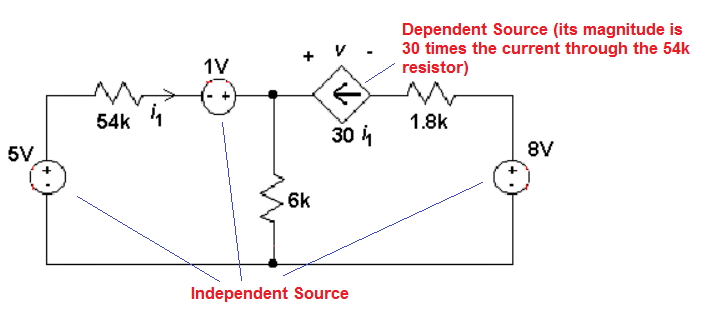
The Laws of Circuit
- you can learn
and practice by just reading
Copyright. Charles Kim 2006
-
-
- Dependent
Source?
-
- Consider this situation. You put $1000
into your bank account. After books and burgers and
Starbucks and Multiplex with your debit card, you check
your balance, and lo and behold, you still have $1000!
Unbelieving but equally with greed, you try the same
spending pattern again. And again, $1000 is still there.
No letter from the bank. No phone calls. Your bank
account keeps the same purchasing power of $1000, all the
time. No matter what. You can say your account is
"independant" of whatever is happening. Or a
magic world. The bank account I have is in the real
world. My balance is "dependant" on my spending
and my deposit. Your real-world account is not unlike
mine. The balance may be dependent on your dad's
(hopefully timely) deposit. Or it may be dependent on
your cell-phone bill. Or whatever. In the circuit world,
there are 2 types of sourses (which have supplying
power): independant and dependant (voltage and current)
sources. An independant source is either voltage source
or current source which keeps its supplying power at a
value, like 10[V] or 2[A], and the value does not change
no matter what. When connected to a simple load (which is
anything that consumes power) or a heavy load (which
consumes lot more power), or disconnected from it, the
value does not change. Now you're asking if there is such
a thing. Not in the real world. But it does exist in the
paper. In the classroom and in the book. Then, is it OK
to use in the class such non-existing source? Yes. Why?
It's because of the beautiful and magical hand called
"approximation" or "modeling." Think about your
cell-phone battery. Probably you charge more often than I do. Not because my
battery was made in the Neverland but because simply I talk on my cell-phone
much less. Anyway, for the first day or two, your phone is working perfect.
Even under a harsh condition of hours of non-stop talking. Seemingly not
unlike to the definition of the independant source. Quickly ignoring what
will
happen tomorrow morning, we move ("model") the
cell-phone battery onto the paper as an independent
voltage source. A power supply which is connected to an
electric outlet can be easily modeled as an independent
voltage source without worrying about tomorrow. Another question? Yes.
-
 Where and what are these dependant sources? When
transistor is moved (again "model") onto the
paper, it contains a dependent source. When operational
amplifier is modeled, it contains a dependent source. The magnitude of a dependent
source is dependent on (or "controlled by") either voltage across of an
element in the circuit or current flowing through an element. This means a
circuit component determines the magnitude of a dependent source. Remember independent sources which are cruely
independent. By the way, in modeling, an independent source is
indicated by a circle, while a dependent source by a diamond.
Where and what are these dependant sources? When
transistor is moved (again "model") onto the
paper, it contains a dependent source. When operational
amplifier is modeled, it contains a dependent source. The magnitude of a dependent
source is dependent on (or "controlled by") either voltage across of an
element in the circuit or current flowing through an element. This means a
circuit component determines the magnitude of a dependent source. Remember independent sources which are cruely
independent. By the way, in modeling, an independent source is
indicated by a circle, while a dependent source by a diamond.
- WWW.MWFTR.COM
